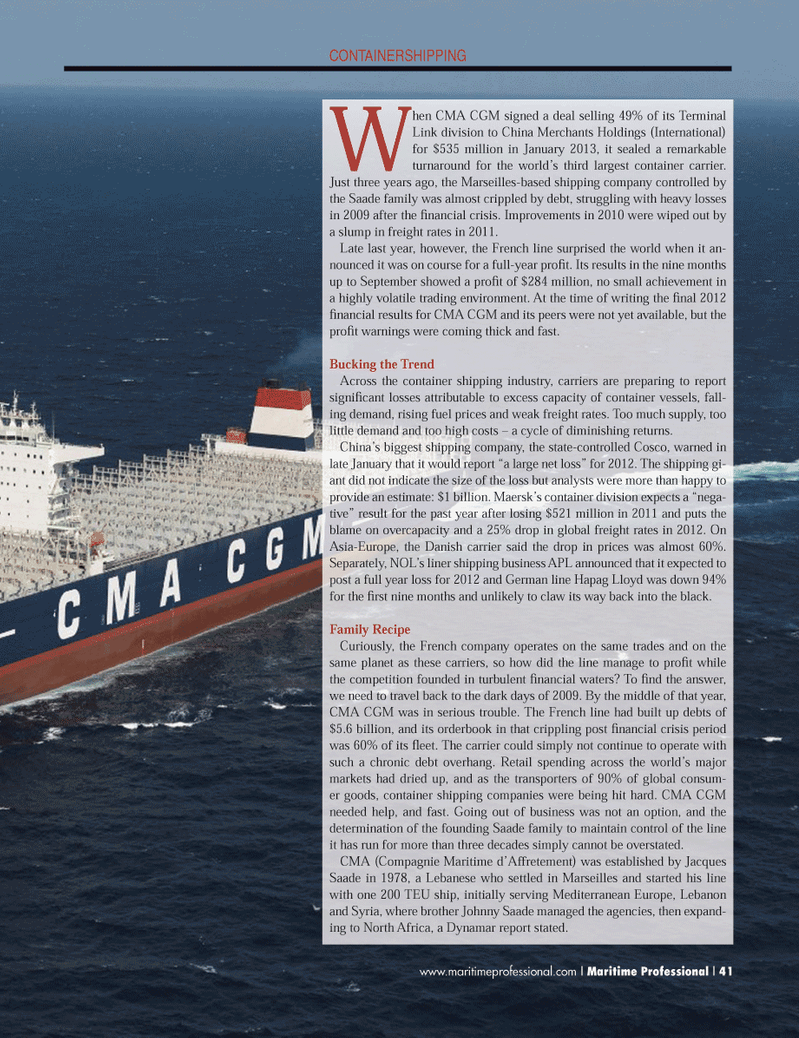
Page 41: of Maritime Logistics Professional Magazine (Q1 2013)
Maritime Risk
Read this page in Pdf, Flash or Html5 edition of Q1 2013 Maritime Logistics Professional Magazine
www.maritimeprofessional.com | Maritime Professional | 41CONTAINERSHIPPING When CMA CGM signed a deal selling 49% of its Terminal Link division to China Merchants Holdings (International) for $535 million in January 2013, it sealed a remarkable turnaround for the world?s third largest container carrier. Just three years ago, the Marseilles-based shipping company controlled by the Saade family was almost crippled by debt, struggling with heavy losses in 2009 after the nancial crisis. Improvements in 2010 were wiped out by a slump in freight rates in 2011.Late last year, however, the French line surprised the world when it an- nounced it was on course for a full-year pro t. Its results in the nine months up to September showed a pro t of $284 million, no small achievement in a highly volatile trading environment. At the time of writing the nal 2012 nancial results for CMA CGM and its peers were not yet available, but the pro t warnings were coming thick and fast. Bucking the Trend Across the container shipping industry, carriers are preparing to report signi cant losses attributable to excess capacity of container vessels, fall- ing demand, rising fuel prices and weak freight rates. Too much supply, too little demand and too high costs ? a cycle of diminishing returns. China?s biggest shipping company, the state-controlled Cosco, warned in late January that it would report ?a large net loss? for 2012. The shipping gi- ant did not indicate the size of the loss but analysts were more than happy to provide an estimate: $1 billion. Maersk?s container division expects a ?nega- tive? result for the past year after losing $521 million in 2011 and puts the blame on overcapacity and a 25% drop in global freight rates in 2012. On Asia-Europe, the Danish carrier said the drop in prices was almost 60%. Separately, NOL?s liner shipping business APL announced that it expected to post a full year loss for 2012 and German line Hapag Lloyd was down 94% for the rst nine months and unlikely to claw its way back into the black. Family Recipe Curiously, the French company operates on the same trades and on the same planet as these carriers, so how did the line manage to pro t while the competition founded in turbulent nancial waters? To nd the answer, we need to travel back to the dark days of 2009. By the middle of that year, CMA CGM was in serious trouble. The French line had built up debts of $5.6 billion, and its orderbook in that crippling post nancial crisis period was 60% of its eet. The carrier could simply not continue to operate with such a chronic debt overhang. Retail spending across the world?s major markets had dried up, and as the transporters of 90% of global consum- er goods, container shipping companies were being hit hard. CMA CGM needed help, and fast. Going out of business was not an option, and the determination of the founding Saade family to maintain control of the line it has run for more than three decades simply cannot be overstated. CMA (Compagnie Maritime d?Affretement) was established by Jacques Saade in 1978, a Lebanese who settled in Marseilles and started his line with one 200 TEU ship, initially serving Mediterranean Europe, Lebanon and Syria, where brother Johnny Saade managed the agencies, then expand- ing to North Africa, a Dynamar report stated. MP #1 34-49.indd 41MP #1 34-49.indd 412/22/2013 11:18:44 AM2/22/2013 11:18:44 AM

 40
40

 42
42
